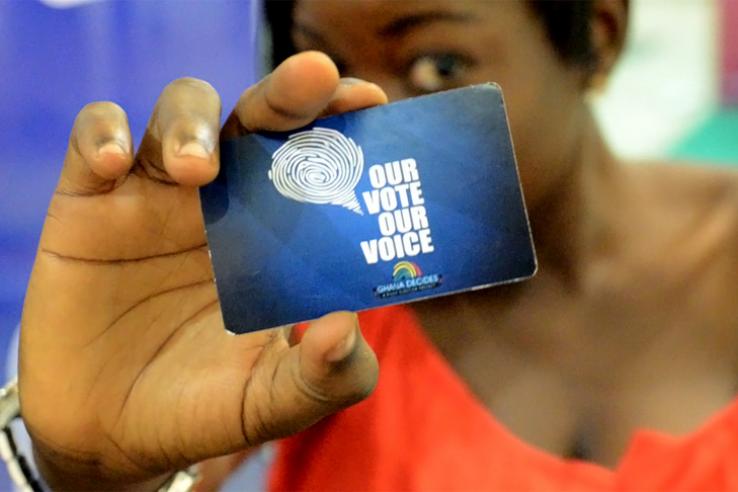
Digital IDs: The good, the bad, and the unknown

Especially in the era of COVID-19, it is hard to imagine a world without WhatsApp or Zoom. Yet, these tech platforms did not even exist two decades ago. These and many other innovations are proof of the ability of digital technology to transform our lives at rapid speed.
These changes extend far beyond just the individual level of messaging apps, reaching a much larger scale, with entire economies becoming more digital. Digitization of economies is being accelerated by the COVID-19 pandemic and provides an opportunity for countries to make large strides towards greater economic development.
Policymakers across sub-Saharan Africa are increasingly investing in a particular digital technology with transformative potential—biometric identification (ID) systems. Biometric IDs are a form of identification that uses biometric information of individuals to record, identify, and verify their identity. They use traits such as fingerprints, eye retina and iris scanning, voice recognition, facial patterns, and body movement as biometric measures of verification. Traditional IDs usually use other documents or people to verify information about someone or are prepared at birth. This step of digitizing ID systems is partly to increase the provision of a legal ID, which is often essential for citizens to access basic government services and lead a dignified life. It will also enable broader use of digital payment systems and promote digitization of services more generally.
Countries like Malawi, Senegal, and Uganda have rolled out national biometric ID systems, while others including Ghana, Kenya, Nigeria, and Tanzania are in the process of implementing mass registration campaigns for their new biometric IDs. More countries still, including Ethiopia, have announced plans to start enrollment for such IDs in the coming months and years. As this digital ID revolution sweeps the continent, what do we really know about its benefits and drawbacks? How does this rapid digitization and proliferation of biometric IDs affect the lives of citizens? And how can they best be structured to result in the most benefit? In this blog, we explore the benefits and drawbacks of digital IDs, as well as the various questions that remain unanswered.
The Good
Overcoming the problems associated with a lack of identification through digital IDs might have powerful implications. A digital repository may make it easier to implement and target government programs, while also enabling citizens to participate in the digital economy. Since these IDs can function as a universally valid proof of identity, they can easily be linked to existing functional systems—like bank accounts and payroll, asset registries, insurance, and school records—to avoid corruption and siphoning of resources, as well as double counting and targeting errors in beneficiaries. By easing processes to obtain voter IDs, drivers’ licenses, telecom services, and banking facilities, IDs can mobilize citizens’ political and economic participation. Additionally, IDs can catalyze the growth of a country’s fiscal capacity by not only minimizing tax evasion but also by being instrumental in promoting financial inclusion and growth of the formal economy. Evidence points to many potential benefits of digital ID systems such as:
- Improved data: It is difficult to allocate funding or identify problem areas without access to quality, granular data. Digital ID systems may alleviate this issue by facilitating improved record-keeping and generating administrative data (routine information collected, used, and stored by governments and other organizations primarily for operational, rather than research purposes) on individuals in the country.
- Improved public service delivery: Many countries plan to link ID systems to digital payment and welfare systems, which should help make public services more efficient and accessible. These policy changes aim to eliminate leakages and enhance the accuracy of transactions as well as the ability of the government to monitor them. When linked with monitoring systems, digital IDs have reduced absenteeism among health workers, reduced data forgery, and improved patient adherence to treatment in India.
- Improved targeting: Following from the previous point, digital ID systems may make it easier to implement and target government welfare programs. Evidence from India shows that biometric IDs cost-effectively increased efficiency of welfare payments by reducing leakages and delays while not reducing program access, particularly to vulnerable households. Further, in India, beneficiaries overwhelmingly preferred the smartcard systems.
- Better credit market efficiency: Digital IDs can help address barriers to accessing formal financial products. Evidence from Malawi shows that fingerprinting for credit can improve loan repayment rates and lead to a better functioning credit market. By using biometric identification, lenders were better able to identify borrowers. Introducing fingerprinting identification for microloans caused high-risk borrowers to take out smaller loans and to improve their repayment behavior.
The Bad
While there are many potential benefits to using digital IDs, they often have their drawbacks. Digital ID systems have seen large pushback in many countries due to fear of exclusion and erosion of privacy. Further, the implementation of digital ID systems could cause more pain than gain in specific contexts such as remote areas with limited connectivity. Governments need to carefully evaluate where digital ID systems will maximize welfare without inconveniencing or excluding the already marginalized. Some of the recorded challenges with digital ID systems are:
- Exclusion errors: Stringent ID requirements can generate non-trivial costs in terms of exclusion and inconvenience to genuine beneficiaries. Evidence from India shows that making biometrics compulsory in the public food distribution system created exclusion problems and increased transaction costs, especially for vulnerable groups, without reducing corruption. These findings were corroborated by a second study, which found that biometric IDs led to limited improvements, such as more timely and reliable recording of PDS transactions, and resulted in the exclusion of households (usually the most vulnerable ones such as widows, the elderly, and manual workers) that were unable to pass the biometric authentication test. The authors argue that the imposition of the digital system here led to “pain without gain” as it did not address the type of leakages that were prevalent in the given context.
- Implementation concerns: Another study in India found that while a biometric attendance-monitoring intervention led to health improvements, its imperfect enforcement illustrated the limitation of technological monitoring solutions when they are not combined with changes in the broader rules governing health workers. While there were some health gains from this, the biometric devices led to lower work satisfaction among staff and increased difficulty hiring new nurses, lab technicians, and pharmacists. As a result of this and other factors, there was limited appetite at all levels of government to use the better quality attendance data to enforce the government’s human resource policies.
- Privacy and data misuse concerns: Biometric authentication raises important privacy and data misuse concerns. There has been major pushback in India and Kenya to biometric national ID systems due to concerns regarding safety and misuse of collected data. Large data sets have been shown to have great power in surveillance, as well as predicting and shaping people’s decisions. In light of this, it is crucial to ensure that strong data privacy and security legal frameworks and systems are in place.
The Unknown
While we are beginning to glean insights on some of the benefits and drawbacks of digital ID systems, many questions remain unanswered, particularly in the context of sub-Saharan Africa. With the broad impacts that digital IDs can have, there is little research on how they can improve the implementation of welfare programs, how these systems and linked programs affect citizens, and what unintended consequences may result from having access to IDs and their associated technology. As government reforms in both IDs and payments advance, rigorous research can help them answer these questions, including providing insights into design questions as reforms scale up.
The Digital Identification and Finance Initiative in Africa (DigiFI)—hosted by J-PAL Africa at the University of Cape Town—aims to fill this evidence gap by generating cutting-edge policy research projects focussed on the study of innovative government payment and ID systems. We lay out our research agenda in our framing paper. Some examples of questions we hope to answers in the digital ID space are:
- What are the best ways to design digital ID linked services for the greatest impact at the lowest cost?
- To what extent and when can digital ID systems improve targeting and efficiency in public programs?
- How can digital ID systems assist in building incentive systems to motivate public servants?
- How do digital IDs affect voter participation, the fairness of elections, and electoral outcomes?
- Can digital IDs promote further digitization in financial systems and thus enhance financial inclusion?
- Can digital ID systems encourage businesses to enter the formal sector? Do these reforms reduce entry costs to entrepreneurship and enable productive investment?
- Can digital ID systems help strengthen law-enforcing institutions and, in turn, affect private investment?
If you are a policymaker interested in jointly understanding how to design digital ID and payment systems in your country or a researcher wanting to add to this body of literature, please reach out to us at [email protected]. We are very interested in understanding digital systems across the continent and are keen to help co-generate analysis that can inform policy decisions on digital ID and payment systems.
Author’s Note: This is the first blog in the DigiFI series on the various aspects of their research and policy priorities. The next blog will focus on government to person digital payments.


